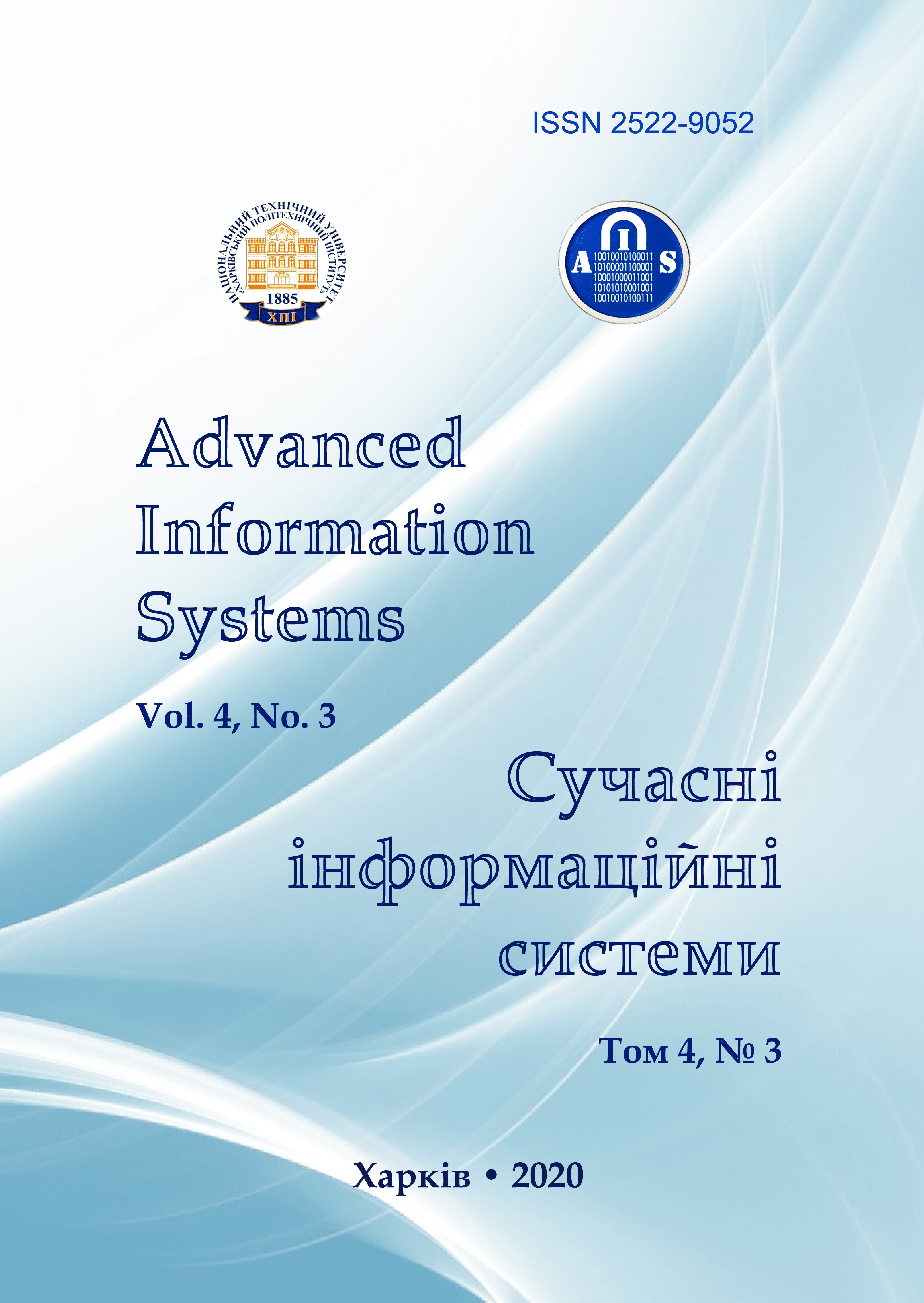Autonomous robot motion control situational planning model
Main Article Content
Abstract
Today, the urgent problem is the autonomous mobile systems navigation in a space where disturbances are possible. The problem is that various disturbances that occur during the robot motion do not allow movement along a pre-planned route and require ongoing re-planning in accordance with the situation received from the sensors. For autonomous systems, the problem is complicated by the need to automatically generate the current situation model based on data from sensors and integrate this situation model with real-time planning and control models. The subject of the research is the knowledge-based models of processing data from sensors used in the autonomous mobile systems navigation. The purpose of the study is the implementation of a rule-based perception cognitive model for the situational control tasks class and re-planning the autonomous robot motion along a route under interference. Investigate the model ability to meet the autonomous systems requirements. Results. Perception data model from sensors is represented by multilevel facts set, in verbal form at generalization different levels, describing the current situation in the robot environment. The knowledge base that the robot uses when navigating is represented by the fuzzy rules five-level hierarchical structure: knowledge about the goals, route and plan for obstacles avoidance, cartographic knowledge about the workspace, strategies and specific control actions necessary to achieve the goal. An algorithm and a program in which the perception model and the modified Takagi-Sugeno model are integrated, which implements situational control with route re-planning have been developed. To study the model, an artificial environment was developed and the results of computer experiments on moving the robot along a given route surrounded by obstacles are presented. Conclusions. The consistency of the perception model implementation for the robot navigation tasks class is shown. The perception model, integrated with the modified Takagi-Sugeno model, solves the situational control problems with route re-planning and satisfies the autonomous systems requirements and has advantages over the program methods and heuristic management according to the criteria of flexibility, scalability and processing of uncertainty.
Article Details
References
Mintchell, G. (2016), “Industry 4.0 survey: building the digital enterprise”. Available at:
https://themanufacturingconnection.com/2016/09/industry-4-0-survey-building-digital-enterprise.
Darlington, P. (2017), “Rail industry capability delivery plan”. Available at: https://www.railengineer.co.uk/2017/02/16/rail-industry-capability-delivery-plan.
Duarte, F. and Ratti, C. (2018), “The impact of autonomous vehicles on cities: a review”, Journal Of Urban Technology, No. 25 (4), pp. 3-18, DOI: https://doi.org/10.1080/10630732.2018.1493883.
Stachniss, C. (2009), Robotic mapping and exploration, Springer-Verlag Berlin Heidelberg, 198 p., DOI: https://doi.org/10.1007/978-3-642-01097-2.
Rone, W. and Ben-Tzvi, P. (2013), “Mapping, localization and motion planning in mobile multi-robotic systems,” Robotica. Cambridge University Press, No. 31 (1), pp. 1-23, DOI: https://doi.org/10.1017/S0263574712000021.
Bresson, G., Alsayed, Z., Yu, L. and Glaser, S. (2017), “Simultaneous localization and mapping: a survey of current trends in autonomous driving”, IEEE Trans. On Intelligent Vehicles, No. 2 (3), pp. 194-220, DOI: https://doi.org/10.1109/TIV.2017.2749181.
Fuentes-Pacheco, J., Ruiz-Ascencio, J. and Rendón-Mancha, J. (2012), “Visual simultaneous localization and mapping: a sur-vey”, Artificial Intelligence Review, No. 43 (1), pp. 55-81, DOI: https://doi.org/10.1007/s10462-012-9365-8.
Hoy, M., Matveev, A. and Savkin, A. (2014), “Algorithms for collision-free navigation of mobile robots in complex cluttered environments: a survey”, Robotica, No. 33 (3), pp. 463-497, DOI: https://doi.org/10.1017/s0263574714000289.
Lv, T., Zhao, C. and Bao, J. (2017), “A global path planning algorithm based on bidirectional SVGA”, Journal Of Robotics, Vol. 2017, pp. 1-11, DOI: https://doi.org/10.1155/2017/8796531.
Lu, Y., Xue, Z., Xia, G. and Zhang, L. (2018), “A survey on vision-based UAV navigation”, Geo-Spatial Information Science, No. 21 (1), pp. 21-32, DOI: https://doi.org/10.1080/10095020.2017.1420509.
Mac, T., Copot, C., Tran, D. and De Keyser, R. (2016), “Heuristic approaches in robot path planning: A survey”, Robotics And Autonomous Systems, Vol. 86, pp. 13-28, DOI: https://doi.org/10.1016/j.robot.2016.08.001.
Yufka, A. and Parlaktuna, O. (2009), “Performance comparison of bug algorithms for mobile robots”, 5th International Ad-vanced Technologies Symposium (IATS’09), pp. 61-65, DOI: https://doi.org/10.13140/RG.2.1.2043.7920.
McGuire, K., de Croon, G. and Tuyls, K. (2019), “A comparative study of bug algorithms for robot navigation”, Robotics And Autonomous Systems, Vol. 121, DOI: https://doi.org/10.1016/j.robot.2019.103261.
Russel, S. and Norvig, P. (2010), Artificial intelligence: a modern approach, Prentice Hall, 1132 p.
Asada, M., Hosoda, K., Kuniyoshi, Y., Ishiguro, H. and Inui, T. (2009), “Cognitive Developmental Robotics: A Survey”, IEEE Trans. On Autonomous Mental Development, No. 1 (1), pp. 12-34, DOI: https://doi.org/10.1109/tamd.2009.2021702.
Alippi, C. (2014), Intelligence for Embedded Systems, Springer International Publishing, 283 p., DOI: https://doi.org/10.1007/978-3-319-05278-6.
Kargin, A. and Petrenko, T. (2020), “Advances in spatio-temporal segmentation of visual data” in Mashtalir, V., Ruban, I., and Levashenko, V. (eds) Advances in Spatio-Temporal Segmentation of Visual Data, Studies in Computational Intelligence, Vol. 876. Springer, Cham, DOI: https://doi.org/10.1007/978-3-030-35480-0_3.
Kargin, A., Panchenko, S., Vasiljevs, A. and Petrenko, T. (2019), “Implementation of cognitive perception functions in fuzzy situational control model”, Procedia Computer Science, Vol. 149, pp. 231-238, DOI: https://doi.org/10.1016/j.procs.2019.01.128.
Kargin, A. and Petrenko, T. (2017), “Abstragirovanie i kategorizatsiya v umnyih mashinah na osnove granulyarnyih vyi-chisleniy [Abstraction and categorization in smart machines based on granular computations]”, Visnyk Natsionalnoho tekhnich-noho universytetu “KhPI”, No. 50, pp. 130-141, DOI: https://doi.org/10.20998/2411-0558.2017.50.06.
Kargin, A. (2010) Vvedenie v intellektualnyie mashinyi. Kniga 1. Intellektualnyie regulyatoryi [Introduction to intelligent ma-chines. Book 1. Intelligent Regulators], Nord-Press, Donetsk, 526 p.
Kargin, A., Ivaniuk, O., Galych, G. and Panchenko, A. (2018), “Polygon for smart machine application”, 2018 IEEE 9th Int. Conf. on Dependable Systems, Services and Technologies, IEEE, pp. 464-468, DOI: https://doi.org/10.1109/DESSERT.2018.8409178.
